|
|
|
||||
|
|
|||||
|
|
|
|
|
|
|
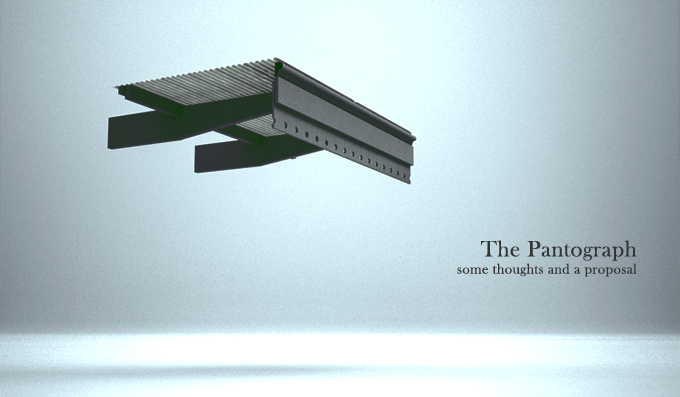
*UPDATE* 15_01_01
Many of the ideas here expressed about "The Pantograph" have evolved into a Game/Art project called "A Light In Chorus" that I'm currently working on with my friend and fellow art school grad Matthew Warshaw, more details can be found at www.lightchorus.com
"The Pantograph" is far from dead, but work will resume once I can afford to finish it! If you're interested in some of the background of A Light In Chorus I would encourage you to read on none-the-less...
13_07_10
Some Background
"The Pantograph" exists as a series of sketches, photographs and concept renders. Apart from the image above, these are not online yet. It is also a collection of research materials and written notes that I've made over the last few years, about a project that imagines a freestanding camera obscura as a kind of historical black hole; its ever roaming eye sucking in localized events of upheaval and catastrophe through the passage of time. I like the idea that this act of observation might be involved or even responsible for the destruction it witnesses, and that as a narrative device this could be a powerful way to tell the story of and around a specific area.
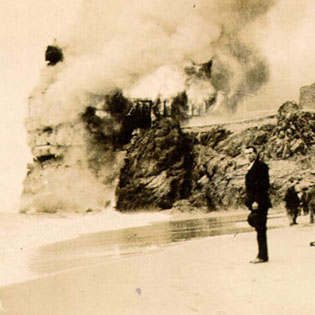 The Sutro Cliff House, on fire, 1907| Image: Cliff House Project
The Sutro Cliff House, on fire, 1907| Image: Cliff House Project
I think it's worth noting that these ideas came about specifically in response to the history of the San Francisco Cliff House ( which I first saw thanks to Geoff Manaugh's fantastic BLDGBLG) and the small camera shaped building next to it, The Jennings Camera Obscura. The Cliff House was and is a striking building (and surrounding area) with a rich history of folklore, disaster and rebirth- it's been destroyed and rebuilt five times since the 1850's, each version architecturally distinct. The most remarkable version being Adolph Sutro's terrifying gothic mansion hovering above the sea and rocks below. The fact that it survived the great earthquake of 1906 and then burnt down the next year due to faulty electrics only adds to its bizzarre charm. Better still, there is a persistent myth that Wikipedia (among others) its original incarnation was made from "...lumber salvaged from a ship that foundered on the basalt cliffs below." Further research shows the wood probably came from the lumber carried by a wrecked cargo ship at Point Lobos (some 100 miles away) but nevertheless the embellishment is an enjoyable one- no citation is given but nor is it needed- it's the myth that's the appeal of the house (the current buisiness owners no doubt relish this and have a facebook page full of great artifacts from its odd history).
More recently the project has shifted direction (and continent) as a response to ARTANGEL's OPEN initiative to comission site specific work in the UK. Hopefully it retains some of the intrigue of the orignal idea and the obscura can be used as a device to tell a different story, one of landscape but also of looking and how the two might inform each other.
Below you can find my original proposal as well as on the ARTANGEL Website as published in the ARTANGEL Open 100. The project is still very much in development (ideas have evolved since the proposal and I'll keep updating this page as I get the time to write it up) but I'm putting this here to keep up the momentum, and to get people interested, so if you like what you read or think you may be able to help out with production, please get in touch.
"The Pantograph" Eliott Johnson, 2013
I'm proposing to make a film about the overnight appearance of a monumentally large freestanding camera obscura on the Isle of Sheppy in Kent. The film's narrative will be woven around visual meditations on the surrounding landscape intercut with shots of architectural explorations of the building and its mechanics: close-ups of its surfaces and materials, demonstrations of its moving parts and ultimately the images it projects- views of the marshlands and north sea but also 3D rendered visualisations of the local sea floor and shipwrecks made from hi-resolution sonar data.
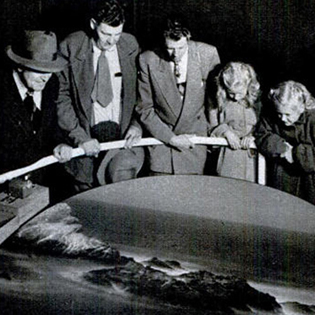 Inside the Jennings Obscura| Image: Popular Mechanics, March, 1952
Inside the Jennings Obscura| Image: Popular Mechanics, March, 1952
The proposed camera's mechanics are partially inspired by the Jennings Camera Obscura in San Francisco- a 1940's seaside attraction - that has a motorized lens continuously rotating the view 360 degrees every few minutes, projecting onto a parabolic focusing screen in the centre of the building. The device’s proximity to the sea and this persistent rotation provide a visual framework for its reimagining as the inversion of a lighthouse in my film- sucking light in, obscuring rather than illuminating. In this way I imagine it a symbolically dangerous and mysterious device; a voyeuristic means to explore spatial history, specifically one with a tendency towards catastrophe.
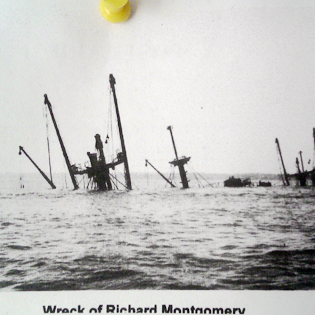 The SS Richard Montgomery| Image: Sheerness Heritage Museum
The SS Richard Montgomery| Image: Sheerness Heritage Museum
The decision to use Sheppy as a location is motivated by the abundance of shipwrecks along its coast- owing to its location at the mouth of the Thames Estuary, an important shipping route, both now and historically. In particular much of the film will take place around the town of Sheerness, focusing on the wreck of the SS Richard Montgomery which sits a mile and a half from the shore, three of its masts still poking out from the water. The US cargo ship sank on a sandbank in 1944 carrying around one and a half thousand tonnes of explosives (allegedly comparable to a small nuclear weapon) which rests undetonated. While regular surveys are taken of the wreck to ensure its stability, it remains a controversial presence, with an exclusion zone around it, most recently threatening to scupper Boris Johnson’s plan to build an airport island (“Boris island”) on the Thames Estuary.
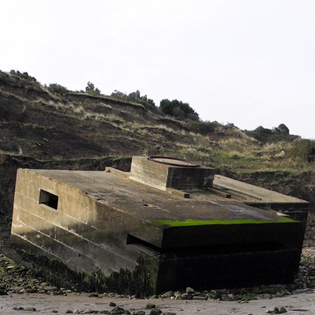 Pillboxes at Warden Point, Sheppy| Image: sheppeyfossils.com
Pillboxes at Warden Point, Sheppy| Image: sheppeyfossils.com
The wreck thus becomes an antagonistic presence in the film, simultaneously threatening and uncertain, its masts standing in oppositional symmetry to the brutalistic but ramshackle architecture of the obscura. The building’s architectural style will take cues partly from the Victorian seaside attractions that inspired it, but also from the cast concrete of the ruined pillboxes and acoustic mirrors found around Sheppy and the Kent coast, giant and intimidating structures now fallen into disrepair or half buried in the sea. A fortified lighthouse or peculiarly decorated Martello Tower made of weather beaten concrete and iron, it stands proclaiming an illusory permanence.
These references underpin one of the primary thematic concerns of the piece; to create and explore an optical counterpoint to the aforementioned iconic acoustic mirror, both functionally and aesthetically. While the mirrors are able to make sounds that are distant feel close, the camera obscura has the ability to expose and enlarge objects normally concealed by distance. Both technologies astound and entertain because they defy established notions of sensation. Transporting the outside world to a large dish in a darkened room is an idea heavily loaded with visual analogies and references, conjuring images of witch's cauldrons or divine chess boards which will be played upon in the film.
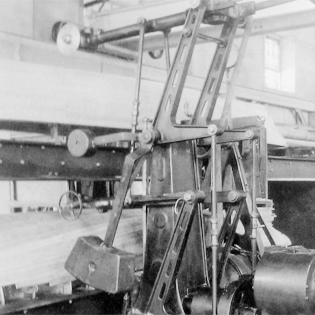 A Pantograph, Model building Shop| Image: Mariners Museum, Va.
A Pantograph, Model building Shop| Image: Mariners Museum, Va.
"The Pantograph" alludes to the camera obscura's conceptual ability to make a copy of the outside world- a model of the world at a manageable scale. A Pantograph is a mechanical arm originally invented to make scale drawings and reproductions, a device later adapted for, and essential to, the manufacture of ships. The arm traces the curvature of small wooden engineering models, amplifying a much larger connected arm's movements, carving out the final lines used to construct the ship.
I intend to realise the building itself through photo-real CGI (my primary medium) composited against the bleakly beautiful marshlands and beaches of the Thames Estuary for the exterior shots. Interior shots will be comprised of footage shot inside the remaining camera obscura attractions across the UK, building up a sort of “uber-obscura"- an amalgamated picture of the machines workings and housing, a cinematic space neither entirely fictional nor real.
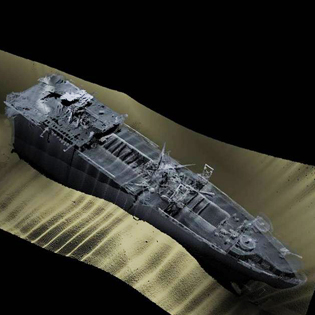 Sonar Scan of The SS Richard Montgomery| Image: ADUS
Sonar Scan of The SS Richard Montgomery| Image: ADUS
The camera obscura is useful both as an analogy for the mechanics of our vision but also as means to connect with the past; its ability to reveal that which is distant, or uncover what is normally unseen makes it ideally suited to reveal seemingly lost parts of history. When the film comes to show us the obscura’s projected images, the narrative will leap in and out of different ways of seeing, presenting both historical and (budget permitting) newly commissioned high resolution sonar scans of the surrounding seabed. This is the same technology that is yearly used to assess the risk caused by the SS Richard Montgomery, and part of the film will be re-visualising the existing data. This will of course have to be in coordination with the team of researchers at Universty of Dundee and St Andrews currently responsible for its surveillance. I wish to literally reprocess their data to create new visual interpretations of the site but also to re-present the standard visualisation method- which emphasises the ghost-like appearance of shipwrecks, rusting hulls made up of tiny glowing dots, a thin layer of luminous digital dust.
These 3D point clouds render an aesthetically fantastical and foreign underwater landscape now accessible- CGI enabling a virtual camera to move freely around and even through the inside of the wrecks. In this way the narrative forms a loop, moving from the camera obscura- a technological relic once at the forefront of the visual arts and entertainment, to the modern equivalent of computational photography, allowing us to look and see in ways which were previously entirely impossible. "The Pantograph" will ultimately provide both an alternate history of an area but also a history of looking at the world around us, and the means in which visual technologies are constantly redefining what we consider to be landscape.